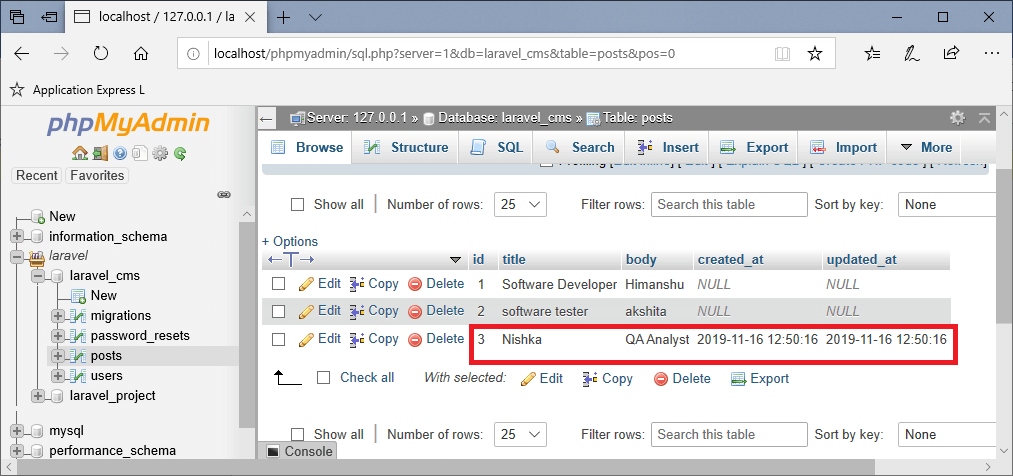

- #Order by laravel eloquent update
- #Order by laravel eloquent software
- #Order by laravel eloquent code
- #Order by laravel eloquent free
The Laravel framework is open-sourced software licensed under the MIT license. If you discover a security vulnerability within Laravel, please send an e-mail to Taylor Otwell via All security vulnerabilities will be promptly addressed.
#Order by laravel eloquent code
In order to ensure that the Laravel community is welcoming to all, please review and abide by the Code of Conduct. Thank you for considering contributing to the Laravel framework! The contribution guide can be found in the Laravel documentation. If you are interested in becoming a sponsor, please visit the Laravel Patreon page. We would like to extend our thanks to the following sponsors for funding Laravel development. Boost your skills by digging into our comprehensive video library. Laracasts contains over 2000 video tutorials on a range of topics including Laravel, modern PHP, unit testing, and JavaScript. If you don't feel like reading, Laracasts can help. You may also try the Laravel Bootcamp, where you will be guided through building a modern Laravel application from scratch. Laravel has the most extensive and thorough documentation and video tutorial library of all modern web application frameworks, making it a breeze to get started with the framework. Laravel is accessible, powerful, and provides tools required for large, robust applications.

Multiple back-ends for session and cache storage.Powerful dependency injection container.Laravel takes the pain out of development by easing common tasks used in many web projects, such as: The Eloquent collection object extends Laravel's base collection, so it naturally inherits dozens of methods used to fluently work with the underlying array of Eloquent models. We believe development must be an enjoyable and creative experience to be truly fulfilling. This property maps various points of the Eloquent model's lifecycle to your own event classes.Laravel is a web application framework with expressive, elegant syntax. To start listening to model events, define a $dispatchesEvents property on your Eloquent model. Event names ending with -ing are dispatched before any changes to the model are persisted, while events ending with -ed are dispatched after the changes to the model are persisted. The saving / saved events will dispatch when a model is created or updated - even if the model's attributes have not been changed. The updating / updated events will dispatch when an existing model is modified and the save method is called. When a new model is saved for the first time, the creating and created events will dispatch. The retrieved event will dispatch when an existing model is retrieved from the database. Want to broadcast your Eloquent events directly to your client-side application? Check out Laravel's model event broadcasting.Įloquent models dispatch several events, allowing you to hook into the following moments in a model's lifecycle: retrieved, creating, created, updating, updated, saving, saved, deleting, deleted, trashed, forceDeleting, forceDeleted, restoring, restored, and replicating. This method also accepts an optional attribute argument: The isClean method will determine if an attribute has remained unchanged since the model was retrieved. You may pass a specific attribute name or an array of attributes to the isDirty method to determine if any of the attributes are "dirty". The isDirty method determines if any of the model's attributes have been changed since the model was retrieved. This is because the models are never actually retrieved when issuing a mass update.Įloquent provides the isDirty, isClean, and wasChanged methods to examine the internal state of your model and determine how its attributes have changed from when the model was originally retrieved.
#Order by laravel eloquent update
When issuing a mass update via Eloquent, the saving, saved, updating, and updated model events will not be fired for the updated models. The update method returns the number of affected rows. The update method expects an array of column and value pairs representing the columns that should be updated. You may use the make:model Artisan command to generate a new model: Models typically live in the app\Models directory and extend the Illuminate\Database\Eloquent\Model class. To get started, let's create an Eloquent model. It's a great way to get a tour of everything that Laravel and Eloquent have to offer. The Laravel Bootcamp will walk you through building your first Laravel application using Eloquent.
#Order by laravel eloquent free
If you're new to Laravel, feel free to jump into the Laravel Bootcamp.

For more information on configuring your database, check out the database configuration documentation. In addition to retrieving records from the database table, Eloquent models allow you to insert, update, and delete records from the table as well.īefore getting started, be sure to configure a database connection in your application's config/database.php configuration file. When using Eloquent, each database table has a corresponding "Model" that is used to interact with that table. Laravel includes Eloquent, an object-relational mapper (ORM) that makes it enjoyable to interact with your database.


 0 kommentar(er)
0 kommentar(er)
